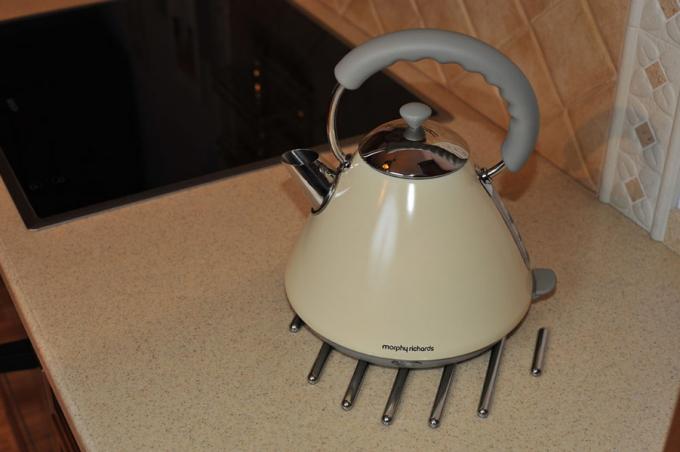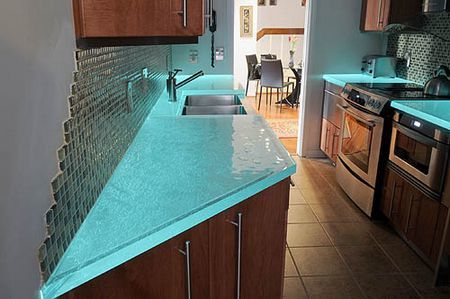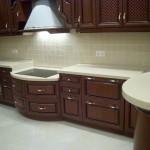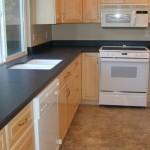Content
- 1 What it is
-
2 What it is
- 2.1 Agglomerate (quartzite)
-
2.2 Acrylic artificial stone
- 2.2.1 Features of operation
- 3 Alternatives
- 4 Conclusion
The topic of our article is artificial stone countertops for the kitchen. What is this material? What are its pros and cons? Does it have any subspecies? Are there any reasonable alternatives to its use? Let's figure it out.

No, this is not polished granite. Before us is a completely artificial material that is not inferior to it in strength.
What it is
Artificial stone based on stone chips and synthetic resins has nearly half a century of history. It was created in 1967 by representatives of the DuPont company and is currently produced around the world under various brands.
The main feature of the artificial stone for the kitchen countertop is the almost complete absence of pores on the surface.
Why is this good?
- Antibacterial properties of the material. The perfectly smooth surface means that food debris and moisture will not linger in pores and micro-cracks and will not become food for microorganisms.
- Lack of contamination. After all, dirt also lingers in the pores, and the fewer there are, the cleaner the countertop will be, the easier it is to remove those traces from it that will still be left by cooking dinner or spilled ketchup.
Even more than a smooth surface, another property of the material is appreciated. Think back to the kitchen tables of your childhood. Remember in detail their corners and surfaces.
Inevitable cracks, cuts on plastic or wood from a knife, and in some places - peeling paint or peeling plastic, right?
Read the details here: Types of kitchen countertops - what are their main advantages and disadvantages.
As opposed to the countertops you may remember, the faux stone kitchen countertop is almost timeless. Its appearance in five and twenty years will be EXACTLY the same as at the time of manufacture. It is problematic to leave cuts on it, there will be no cracks either.
However: but chips, just like in the case of natural stone, are quite possible. Strong blows are best avoided.

A strong enough blow can leave marks.
Does the material have any drawbacks?
Perhaps there is only one weighty one. Price. Its lower limit is about 7,000 rubles per running meter of countertop, but it is easy to find three times more expensive offers.
Perhaps it is worth mentioning that it is very difficult to change the shape of the countertop, to somehow correct the outlines of the kitchen set with your own hands.
No, the instructions for cutting an artificial stone are no different from its natural counterpart: a grinder with a stone circle cuts the countertop without problems. Though slowly. But to make the cut perfectly even, give the edge a rounded shape and polish, you will hardly be able to.
What it is
We have already found out the composition of the artificial stone: a mineral filler and a binder resin. Depending on the ratio in which they form the material studied by us, two types of it are distinguished.
Agglomerate (quartzite)
Structure:
- Quartz chips.
- Pigments that, in combination with a combination of several types of quartz, give different colors to the material.
- The binder is polyester resin.
The mass fraction of quartz is at least 90 percent. The material, therefore, consists almost entirely of natural stone, and is extremely durable. The production method is vacuum pressing at high temperature. Then the finished slab is hardened and polished.
It is this material that fully possesses all the advantages that advertising so loves to sing about. The kitchen countertop made of artificial stone based on quartz sand is absolutely not cut or afraid of high temperature: you can safely put a hot frying pan on it or removed from heat teapot.
The downside of the material properties is the impossibility of gluing sections of the countertop into a single whole. They are sized to fit and fit end to end.
Why do we even need a docking, why not just make a tabletop of the desired shape? Because, even if you forget about certain technological limitations, a five-meter boomerang-shaped tabletop will not pass through the door.
As we can see, the properties of the material as a whole are beyond praise. However, its cost is maximum: it is these countertops that are most expensive.

Quartzite worktop: maximum reliability at maximum cost.
Acrylic artificial stone
This material has a much more affordable price, while remaining, however, at least three times more expensive than laminate countertops.
What do we get for this money?
- The composition includes, in addition to mineral fillers and pigments, acrylic resin. Moreover, in percentage terms, it seems to dominate. The manufacturers do not indicate the exact ratio - probably because the predominance of ordinary plexiglass in the composition runs counter to the image of an artificial stone.
- Joining of parts is possible with glue based on the same resin that underlies the material. After gluing, the countertop made of artificial stone for the kitchen is polished - and now the joining point cannot be found even with a microscope.
- Thermal conductivity is less than that of natural stone. The material is warm to the touch, which confirms the version about the predominance of acrylic in its composition.
- Due to the specific composition of such an artificial stone countertop for the kitchen, to a much lesser extent than agglomerate, it is afraid of chips. It's easier to scratch it. Fortunately, it is much easier to eliminate scratches: they are sanded with fine emery paper and finally polished with GOI (State Optical Institute) or ordinary dental paste.
- No high temperature resistance. A hot frying pan will not sink into the countertop, of course - mineral additives, remember? - but will leave traces on it.
However: Kitchens are often produced with built-in racks for hot dishes.

The main thing is not to forget about the existence of the stand.
Features of operation
As you have already noticed, before us is a material much more capricious than quartzite.
Let's pay attention to caring for it and some simple rules to remember when using kitchens with artificial stone countertops.
- Do not be fooled by the resistance of acrylic stone to aggressive environments. Acids or acetone will definitely damage it. If they hit the surface, wipe it off immediately, let it dry and get ready to polish the material.
- To remove impurities (very rare - and here the pores are of the minimum size), it is better to use ordinary soapy water.
- Mineral deposits in the sink are removed with chlorine-containing detergents - White or regular bleach. They are applied to the surface and removed after 15 minutes along with the remaining plaque.
- Hard metal scourers are prohibited. Made with acrylic resins, faux stone sinks and kitchen countertops are not easy but can be scratched. However, as we remember, it is not difficult to polish.
- Chop is made on a thick cutting board. Put hot stuff on a stand.

Take the time to get a thick cutting board. You can beat off meat on it without any risk to the countertop.
Alternatives
So, we are faced with two options: either reliability for a lot of money, or a rather average material in terms of operational properties for... well, just big.
Read the article - How to choose a kitchen countertop - advice from a professional designer
Looking for alternative options?
- A natural stone in cost it is located between quartzite and acrylic stone. Against the background of acrylic, there is a gain in greater heat resistance: we remember that a kitchen with a countertop made of artificial stone based on acrylic resin is afraid of temperatures. However, a larger pore size means more impurities.
But natural stone loses to the agglomerate countertop in all respects.
- Tempered glass countertops expensive, but very beautiful and, like artificial stone, have an unlimited service life. However, they are also afraid of splinters and blows.

The glass top in the photo is another almost timeless solution.
- Coating the worktop with polished porcelain stoneware It is easy to do it yourself, and in terms of wear resistance, the surface will not yield to artificial stone. The costs will be reduced many times over. The disadvantage of the project is that the countertop will not be monolithic, and dirt will inevitably collect in the seams (see. additional article Porcelain stoneware for the kitchen - where to apply)
Conclusion
You will find additional information about the features of the material in the video at the end of the article. Happy choice!
Gallery












































